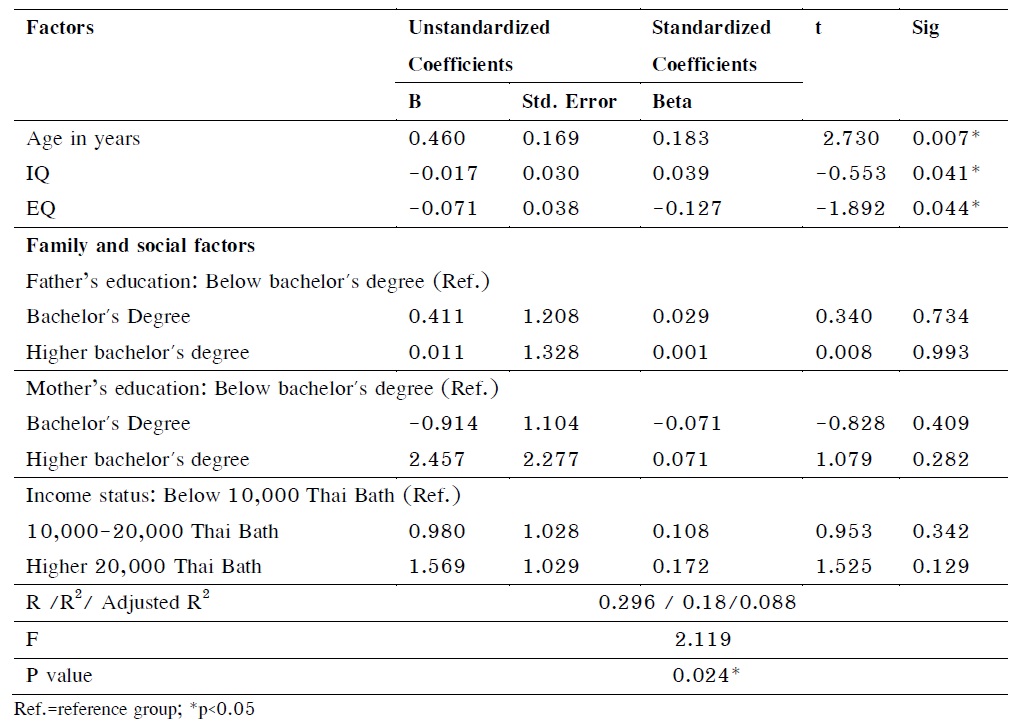ความฉลาดทางสติปัญญา และความฉลาดทางอารมณ์ที่มีผลต่อค่าดัชนีมวลกายในเด็กวัยเรียน กรณีศึกษาจังหวัดนครปฐม
คำสำคัญ:
ความฉลาดทางอารมณ์, ความฉลาดทางสติปัญญา, ภาวะน้ำหนักเกิน, เด็กวัยเรียนบทคัดย่อ
การวิจัยนี้มีวัตถุประสงค์เพื่อ 1) ศึกษาระดับความฉลาดทางสติปัญญา และความฉลาดทางอารมณ์ในเด็กวัยเรียน กรณีศึกษาจังหวัดนครปฐม 2) เปรียบเทียบระดับความฉลาดทางสติปัญญา และความฉลาดทางอารมณ์ในเด็กวัยเรียน จำแนกตามปัจจัยส่วนบุคคล และ 3) ปัจจัยส่วนบุคคล ปัจจัยครอบครัวและสังคมที่มีอิทธิพลต่อค่าดัชนีมวลกายในเด็กวัยเรียน กลุ่มตัวอย่างที่ใช้ คือ เด็กอายุระหว่าง 6–11 ปี จำนวน 266 คน ที่ได้รับการสุ่มเลือกในแต่ละห้องเรียนจากโรงเรียน 3 แห่งในเขตเมืองของจังหวัดนครปฐม ในประเทศไทย โดยใช้เทคนิคการคัดเลือกตามสะดวก เครื่องมือที่ใช้ คือ แบบประเมิน Test of Nonverbal Intelligence Fourth Edition (TONI-4) และ แบบประเมินความฉลาดทางอารมณ์สำหรับเด็ก 6-11 ปี กรมสุขภาพจิต กระทรวงสาธารณสุข วิเคราะห์ข้อมูลโดยสถิติบรรยาย การทดสอบค่าที (Independent Samples t Test) การทดสอบความแปรปรวนทางเดียว (One-Way ANOVA) และการวิเคราะห์สถิติสมการถดถอยเชิงพหุ (Multiple Regression Analysis) ผลการวิจัย พบว่า กลุ่มตัวอย่างผู้ปกครองไม่ถึง ร้อยละ 5 ที่มีการศึกษาอยู่ในระดับสูง และด้านสถานภาพทางครอบครัวและสังคม ร้อยละ 21.43 มีรายได้ครัวเรือนต่อเดือนต่ำกว่า 10,000 บาท นอกจากนี้ ระดับการศึกษาของผู้ปกครองที่ต่างกัน ทำให้เด็กวัยเรียนมีดัชนีมวลกาย และความฉลาดทางสติปัญญาแตกต่างกัน (p<0.05) ขณะที่ระดับรายได้ของครัวเรือนที่ต่างกัน ทำให้เด็กวัยเรียนมีความฉลาดทางอารมณ์และความฉลาดทางสติปัญญาแตกต่างกัน (p<0.05) อย่างไรก็ตาม ปัจจัยส่วนบุคคล ได้แก่ อายุ ความฉลาดทางอารมณ์ และความฉลาดทางสติปัญญา มีผลต่อค่าดัชนีมวลกายของเด็กวัยเรียน ในพื้นที่เขตเมืองของจังหวัดนครปฐม อย่างมีนัยสำคัญทางสถิติที่ระดับ 0.05 (p<0.05)
เอกสารอ้างอิง
Ellulu M, Abed Y, Rahmat A, Ranneh Y, Ali F. Epidemiology of obesity in developing countries: Challenges and prevention. Global Epidemic Obesity 2014;2(1):2.
Department of Health, Ministry of Public Health. The annual reported of department of health [Internet]. 2017 [cited 2019 May 20].Retrieved from: https://www.anamai. moph.go.th/.
Department of Health, Ministry of Public Health. Percentage of school-age children (6-14 years) with onset of obesity and obesity 2021 [Internet]. 2021 [cited 2021 October 12]. Retrieved from: http://dashboard.anamai.moph.go.th/dashboard/overweightstudent?year=2021
Ayana P, Chomchuen T, Tangkawanich T. Factors related obesity behavior of senior high school students in Muang District, Chiang Rai Province. Journal of health Research and Development 2021;7(10):75-89.
Kanazawa S. Intelligence and obesity: Which way does the causal direction go? Current Opinion in Endocrinology, Diabetes and Obesity 2014;21(5):339-44.
Freidl EK, Sysko R, Devlin MJ, Zitsman JL, Kaplan SC, Walsh BT. School and cognitive functioning problems in adolescent bariatric surgery candidates. Surgery for Obesity and Related Diseases 2013;9(6):991-6.
Wong FV. The Association Between Emotional Intelligence, Body Mass Index and Eating Behaviors Among College Students [dissertation]. Master of Science , Hospitality and Dietetic Administration, University of Kentucky; 2011
Homayunnia Firouzjah M, Sheikh A, Homayouni A. Investigating the relationship between emotional intelligence, body image, and eating disorders in team and individual athletes. Journal of Motor Behavior 2014; 15:141-54.
Swami V, Begum S, Petrides KV. Associations between trait emotional intelligence, actual–ideal weight discrepancy, and positive body image. Personality and Individual Differences 2010;49(5):485-9.
Movahhed A, Movahedi A.The effect of body mass index on the emotional intelligence of children. Food and Health 2019;2(1):12-6
Nurmohamadian G, Boland H. The relationship between body image, emotional intelligence, and body mass index. International Journal of Humanities and Cultural Studies (IJHCS) 2016:723-32.
Faul F, Erdfelder E, Buchner A, Lang AG. Statistical power analyses using G* Power 3.1: Tests for correlation and regression analyses. Behavior research methods 2009;41(4): 1149-60.
World Health Organization (WHO). Growth Reference Data for 5-19 Years [Internet]. 2007 [cited 2019 June 3].Retrieved from: http://www.who.int/growthref/en/.
Colom R, Quiroga MÁ, Shih PC, Martínez K, Burgaleta M, Martínez-Molina A, et al. Improvement in working memory is not related to increased intelligence scores. Intelligence 2010;38(5):497-505.
Brown L, Sherbenou RJ,Johnsen SK. Test of Nonverbal Intelligence”, 4th Edition. Austin, TX: PRO-ED;2010
Goleman D. What Make the Leader ? ”, Harvard Business Review 1998;76:93-104
Salahodjaev R, Azam S. IQ and the weight of nations. Personality and Individual Differences 2015;87:105-9.
French MT, Norton EC, Fang HA, Maclean JC. Alcohol consumption and body weight. Health Economics 2010;19(7):814-32.
Philipson TJ, Posner RA. Is the obesity epidemic a public health problem? A review of Zoltan J. Acs and Alan Lyles's obesity, business and public policy. Journal of Economic Literature 2008;46(4):974-82.
Sutin AR, Rogers DL, Mercado A, Weimer A, Rodriguez CC, Gonzalez M, et al. The association between personality traits and body mass index varies with nativity among individuals of Mexican origin. Appetite 2015;90:74-9.
Levitan RD, Davis C. Emotions and eating behaviour: Implications for the current obesity epidemic. University of Toronto Quarterly 2010 ;79(2):783-99.
Kanazawa S. Why liberals and atheists are more intelligent. Social Psychology Quarterly 2010; 73:33-57.

ดาวน์โหลด
เผยแพร่แล้ว
ฉบับ
ประเภทบทความ
สัญญาอนุญาต
บทความทุกบทความที่ตีพิมพ์ในวารสารการพัฒนางานประจำสู่งานวิจัย (JPR2R) ถือว่าเป็นลิขสิทธิ์ของวารสารการพัฒนางานประจำสู่งานวิจัย คณะสิ่งแวดล้อมและทรัพยากรศาสตร์ มหาวิทยาลัยมหิดล





